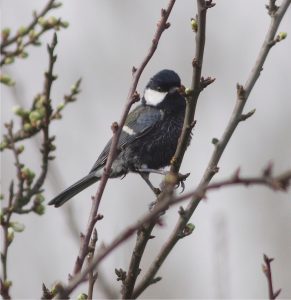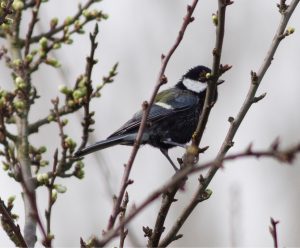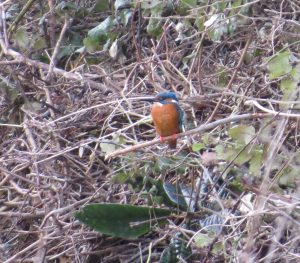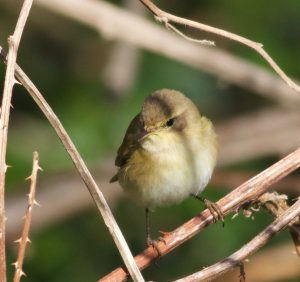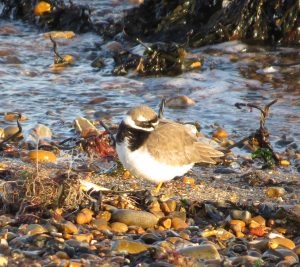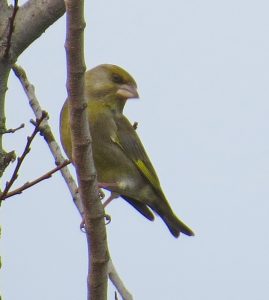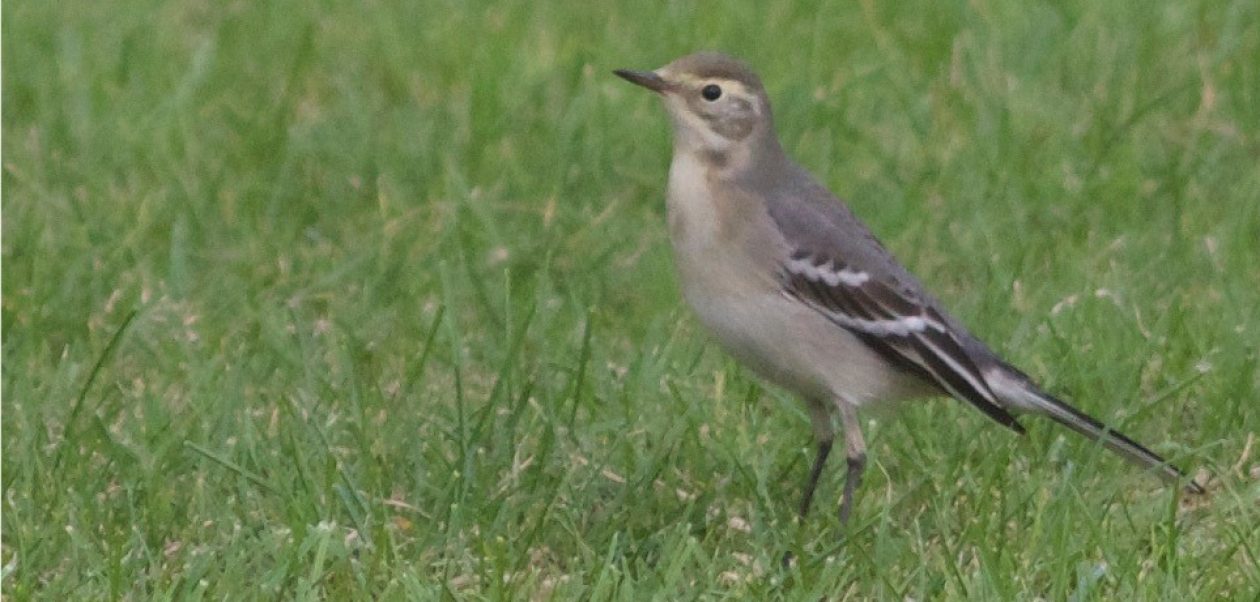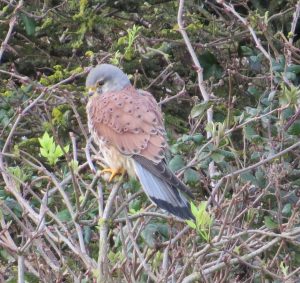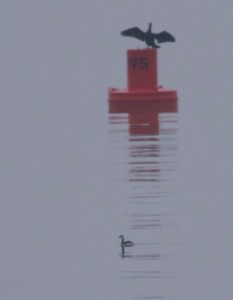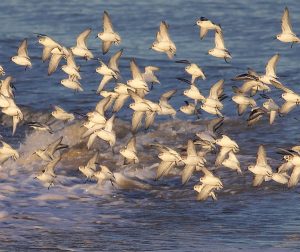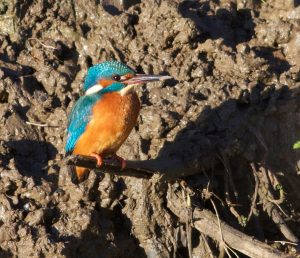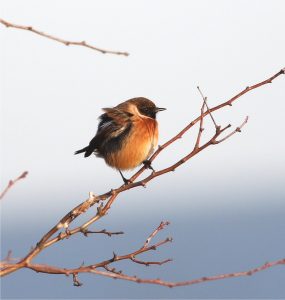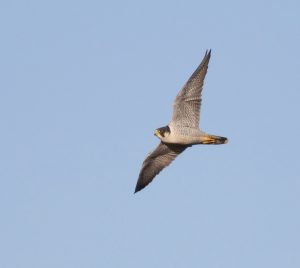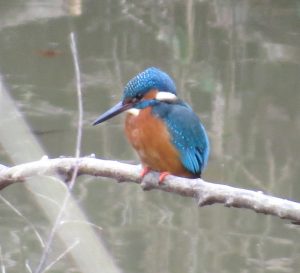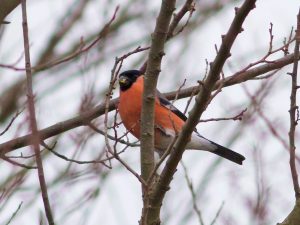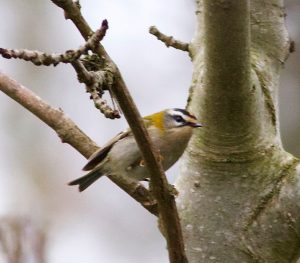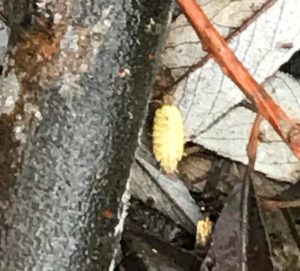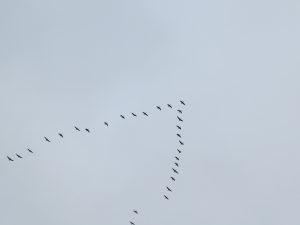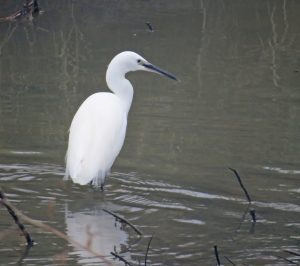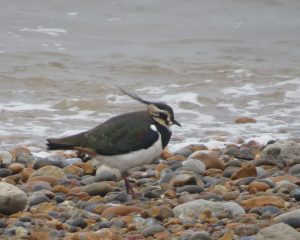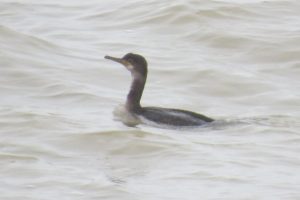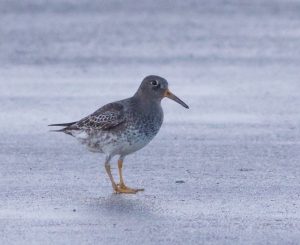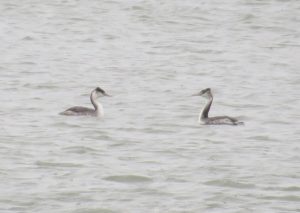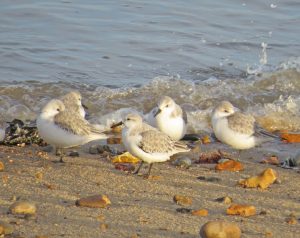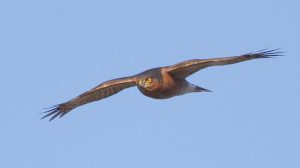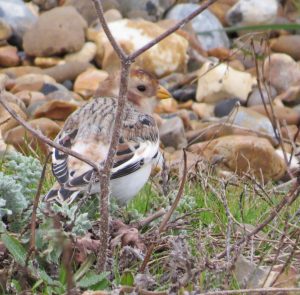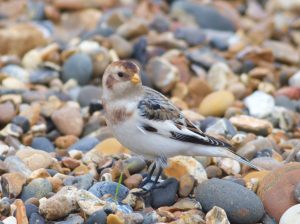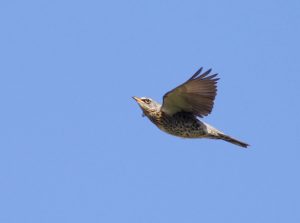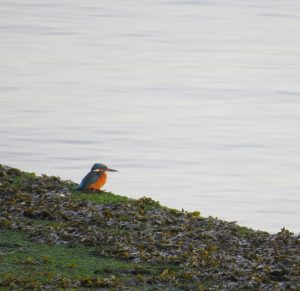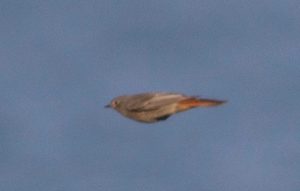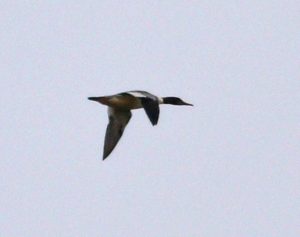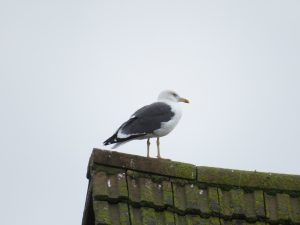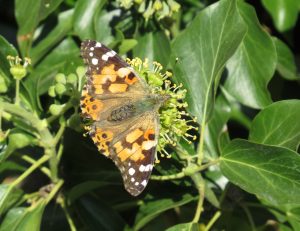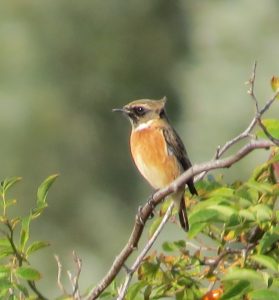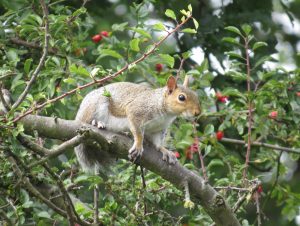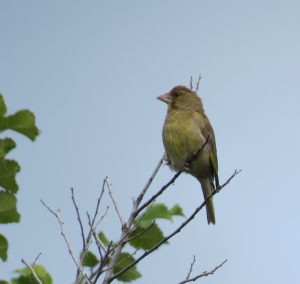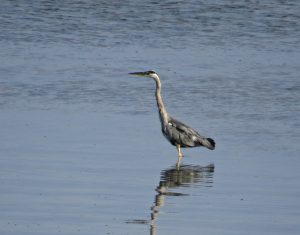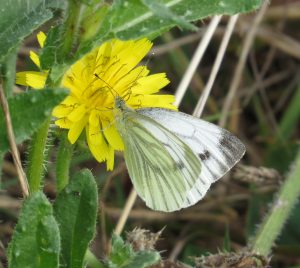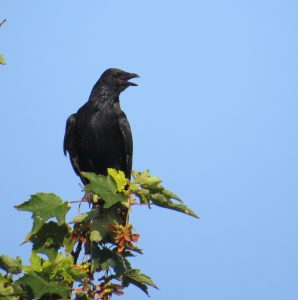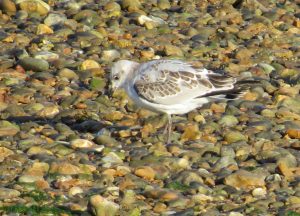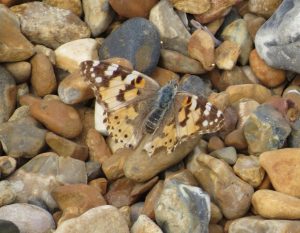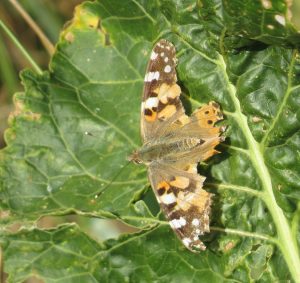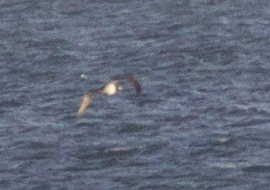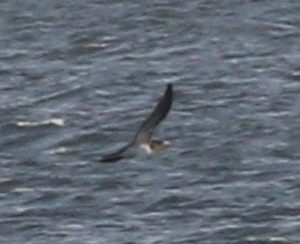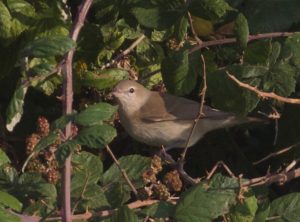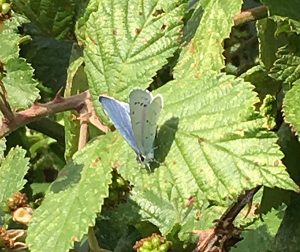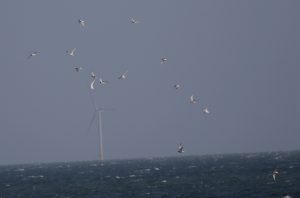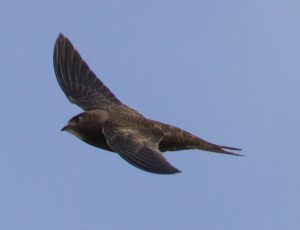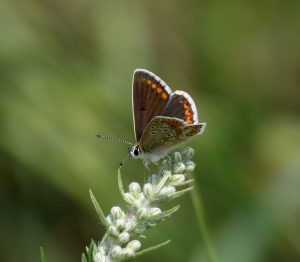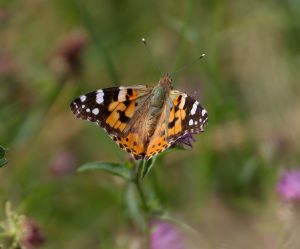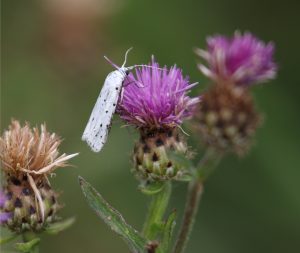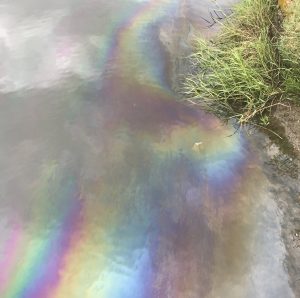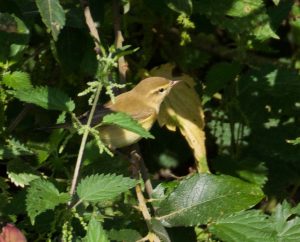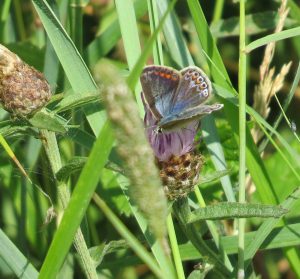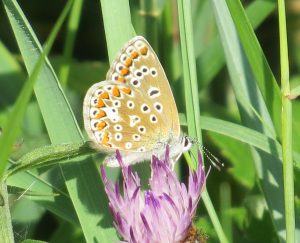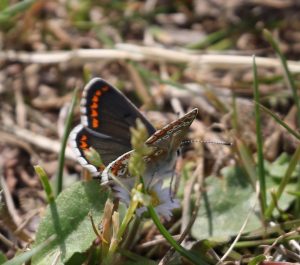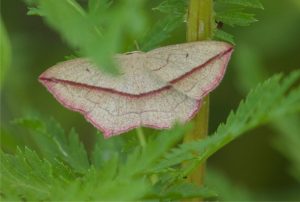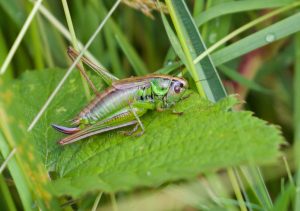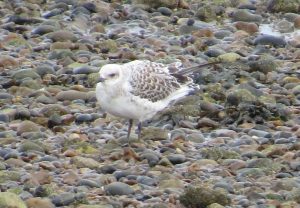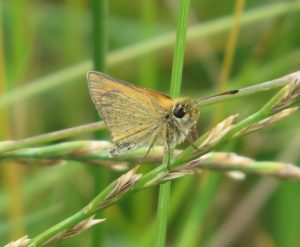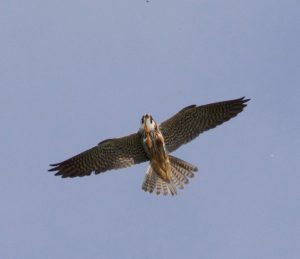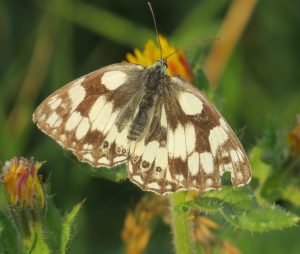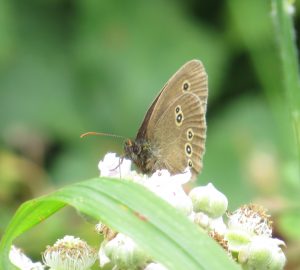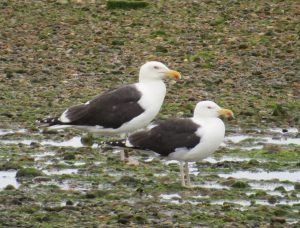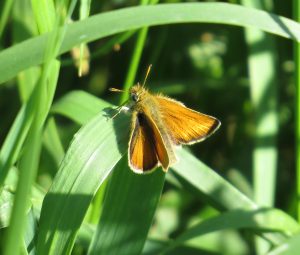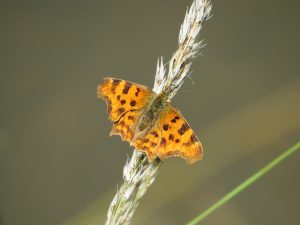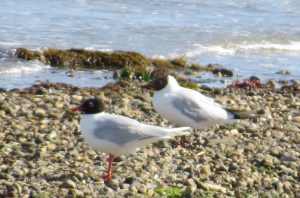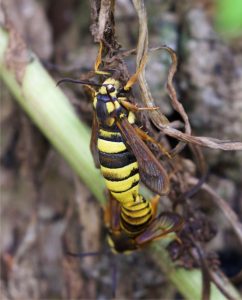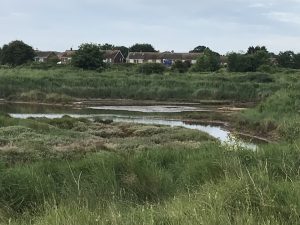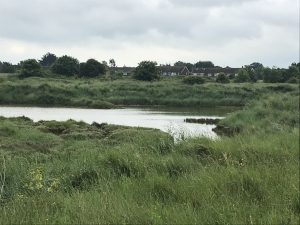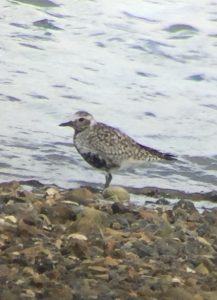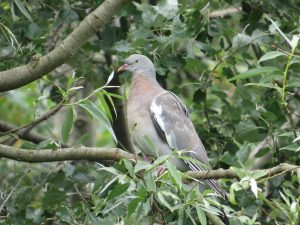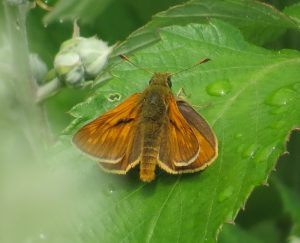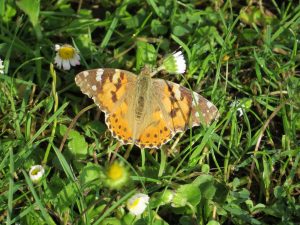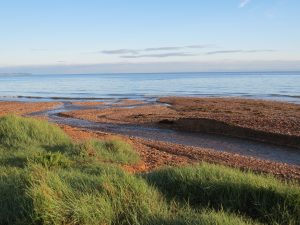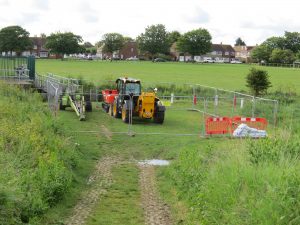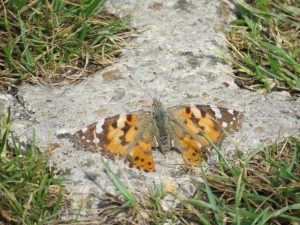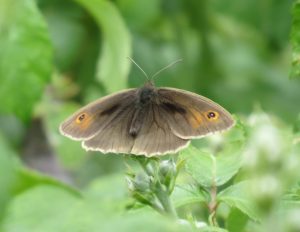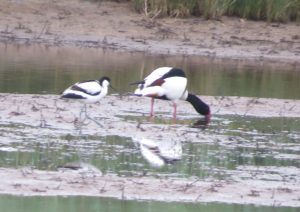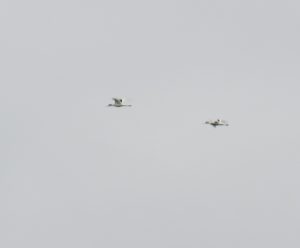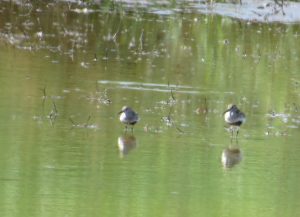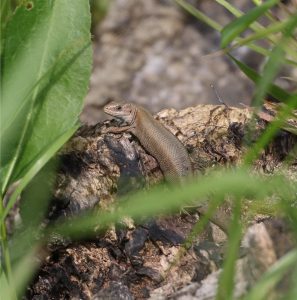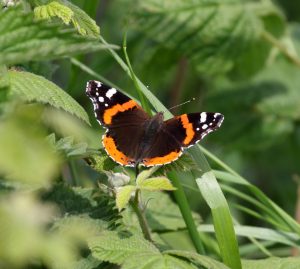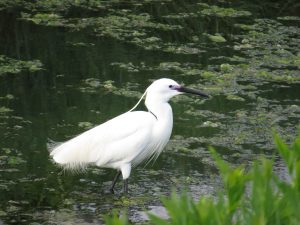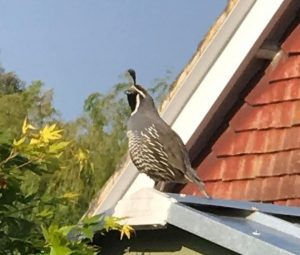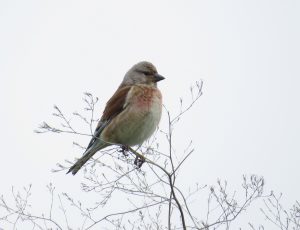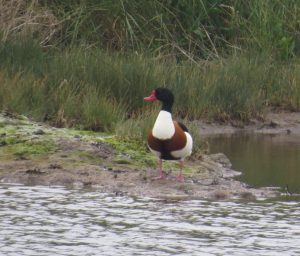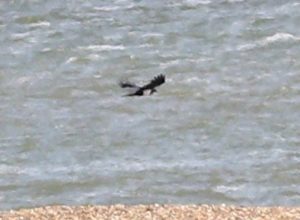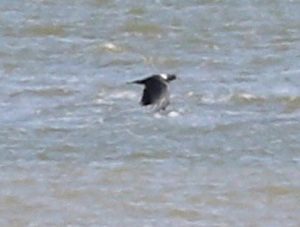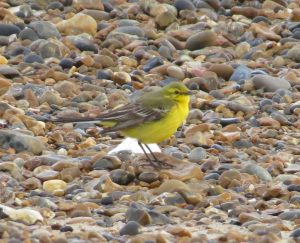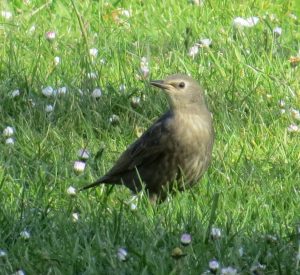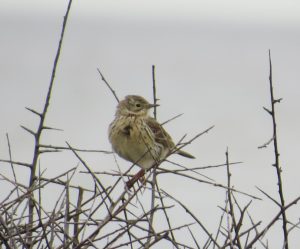161 species so far this year 157 species by the same time last year
An odd month with a slow start, with the briefest views of a Yellow-browed Warbler on 9th the highlight, and a rapid finish with seven additions to the year list in the last four days of the month including a long-awaited first Pallas’s Warbler on 29th. A total of 110 species during the month compared with an average of 108 over the previous ten years (only the second month this year above the average).
31st
Sunny with a light easterly wind. A wildfowl day to end the month with three adult Bewick’s Swans flying west over the estate (just south of the church) at 8.25 am. Earlier two adult Mute Swans flew east over the area and, later, an adult and an immature flew east separately. There were 12 Brent Geese on the beach, three Teal flew over the area, a duck Pintail was on the sea by the tidal ponds and two drake Eiders, separately, flew east. Waders included 63 Ringed Plovers roosting between the groynes, there were ten Sanderlings 20 Dunlins and a Bar-tailed Godwit on the beach and 33 Redshanks, with 18 on the Marsh Pool and 15 on the beach. A flock of 22 Little Gulls were resting on the sea and nine adult Great Black-backed Gulls were on the beach. Other birds included a Peregrine in off the sea and flying south, two Fieldfares and a Redwing.
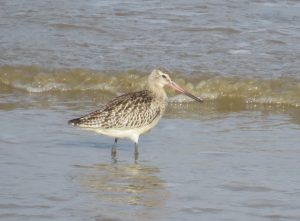
Bar-tailed Godwit – Geoff Burton
30th
No sign of the Pallas’s Warbler today. Movement of wildfowl with an immature Mute Swan, Shelduck, Wigeon, Teal, Pintail and Common Scoters west and a pair of Eiders east. Two juvenile Pomarine Skuas were noted and 19 Little Gulls flew east. There were ten Sanderlings on the beach. Also seen were two Kingfishers and two Goldcrest and, at 12.15 pm, a Shore Lark appeared briefly on the shingle ridge before, inevitably, being flushed by a dog walker.
It was always a disappointment that a rare Wheatear had never been recorded at Swalecliffe, or anywhere along “our” stretch of coast (Swaleciffe west to Oare Marshes). There have been several Desert Wheatears at Reculver and also one at Herne Bay and Sheppey and Pied Wheatear at Reculver and Sheppey. So it was good to hear of Danny Chesterman’s cracking male Desert Wheatear along the South Swale just east of Castle Coote. A pity it wasn’t here!
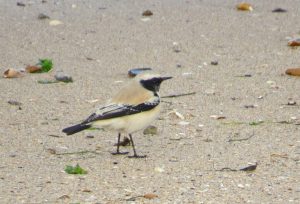
Desert Wheatear – Geoff Burton
29th
Cloudy with rain at first but later, drier with sunny periods. After yesterday’s excellent show, would today be an anti-climax? The answer came at about 10.30 am when Andy found a Pallas’s Warbler along the east bank. A new, if much overdue, addition to the site list (now on 247 species since 1990). The bird showed well for a short time but then became more elusive as a few arrived to twitch the bird. However, it was seen again at 12.30 and, I believe, between 3 and 4 pm. There was a supporting cast, ducks included one Shelduck, six Wigeon, eight Teal, three Pintail, four Shovelers, a Velvet Scoter and a Red-breasted Merganser together with a steady movement of Brent Geese, all heading west. Waders included 72 Ringed Plovers roosting between the groynes and c20 Redshanks on the Marsh Pool. There was one Red-throated Diver, ten Little Gulls, 12 Kittiwakes and one Sandwich Tern. Three Fieldfares and a Redwing were seen, and nine Chiffchaffs and six Goldcrests also (thanks to Brendan’s dark arts!). Finally, a Short-eared Owl (a first this year) came in off the sea at 11.55 am and, judging by the commotion of crows, may have settled in the sewage works whilst it was reported that a Woodcock was flushed from the sewage works entrance.
28th
Sunny, cold with a light northerly wind. Yesterday’s hopes for the northerly wind direction proved mistaken but today, with similar weather conditions, was much better. Quite at first, it burst into life between 8.30-9 am when a Merlin over the beach was distracted by a Woodcock coming in off the sea, which nearly landed by the bluethroat bush, before heading on south. This was followed by two Shore Larks flying west within a group of Skylarks, a redhead Goldeneye west and four duck Eiders east. Three new year ticks! There was a steady vis mig movement which included 20 Skylarks, 174 Fieldfares, eight Redwings, a Tree Sparrow (a fourth new bird for the year), eight Bramblings, three Siskins and a Redpoll. There were hundreds of Gannets offshore, one Red-throated Diver on the sea, c10 Great Crested Grebes including six flying east together, three Shelducks and a Teal west and 40 Common Scoters offshore. Two Pomarine Skuas, five Little Gulls and seven Kittiwakes also flew west. Waders included 47 Ringed Plovers roosting between the groynes, eight Dunlins and a Bar-tailed Godwit, one Lapwing on the Marsh Pool and 22 Redshanks on the beach. Other birds included two Kingfishers,a Grey Wagtail, a male Stonechat, two Chiffchaffs, a Jay and two Reed Buntings. A grand total of 70 species during the morning; the highest for some considerable time!
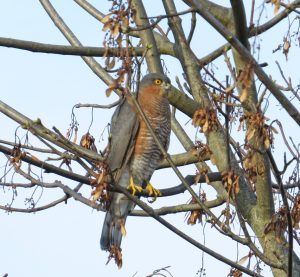
Male Sparrowhawk – Geoff Burton
27th
Cloudy, light NW wind, cooler. There were five Great Crested Grebes in flight offshore. Waders included 53 Ringed Plovers roosting on the beach with five Dunlins, three Sanderlings on the beach, a Snipe and 23 Redshanks on the Marsh Pool, 35 Curlews heading east towards the caravan park fields and one Bar-tailed Godwit flying west. One Sandwich Tern flew east. Vis mig included 15 Skylarks, four Swallows and two House Martins and a party of 30 Siskins heading north over the sea. The Wheatear was still present on the beach (nearly two weeks now), there were two Grey Wagtails near Lang Court, a male Stonechat, three Chiffchaffs and two Reed Buntings.
26th
Cloudy with a moderate W wind. A Red-throated Diver flew east, three Great Crested Grebes flew west and there were about ten Gannets offshore. Waders included 66 Ringed Plovers and seven Sanderlings and four Dunlins roosting on the beach. Later, a single Golden Plover was on the beach. The Lapwing and 25 Redshanks were on the Marsh Pool. The Wheatear continues to inhabit the beach and a Fieldfare was in the scrub. Four Skylarks flew west and about 15 Swallows and ten House Martins were lingering in the area. About 200 Chaffinches flew west during the morning.
Small White butterflies and a Common Darter were also seen.
25th
Cloudy with a strengthening SW wind. A Red-throated Diver flew east and west, there were three Great Crested Grebes offshore and 14 Brent Geese on the beach. Waders included the “resident” Lapwing on the beach, a Snipe on the Marsh Pool (one of many I expect), and 19 Redshanks on the Marsh Pool and then the beach. The Wheatear was on the beach (for its 11th day), there were three Chiffchaffs, a Goldcrest and a Redpoll, flying over the Obs calling, was a new bird for the year.
Butterflies continue to appear in the mild weather with Small White, Red Admiral and Small Copper seen.
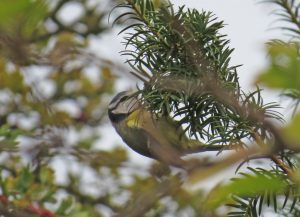
Blue Tit – Geoff Burton
24th
Bird of the day was a Coal Tit (continental) in the bushes near the skate park. New for the year, this was a typical date for this not quite annual migrant. There was a steady movement of Starlings and Chaffinches, with a few Skylarks and Redwings, and a single Swallow and Siskin were noted. Two Goldcrests were also seen. Two Wigeon flew west and there were some Brent Geese offshore.
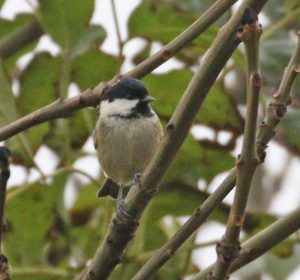
Coal Tit – Andy Taylor
23rd
Cloudy with a light easterly wind. A single juvenile Gannet flew west and flocks of ten Wigeon and 30 Teal as well as a single Tufted Duck also flew west. Waders included a Lapwing and 20 Redshanks on the Marsh Pool, six Dunlin on the beach and a single Snipe flew west. An adult Mediterranean Gull flew east, there were eight Great Black-backed Gulls (including one immature) on the beach and a single Sandwich Tern was offshore. One Swallow flew south, there were two Rock Pipits in the area ans the Wheatear remained on the beach. One Chiffchaff was at the Obs and a flock of Long-tailed Tits was also seen.
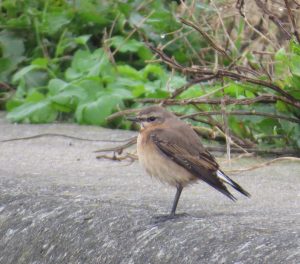
Wheatear – Geoff Burton
22nd
Cloudy with a light NW wind. There were four Great Crested Grebes offshore, four Gannets flew west and there were single Little Egret and Grey Heron on the beach. A pair of Brent Geese were accompanied by four juveniles; it seems to have been a good breeding season for them in Siberia. A single duck Wigeon and two Red-breasted Mergansers flew west and a Marsh Harrier flew east. Waders included a Lapwing and a Snipe on the Marsh Pool, 23 Redshanks on the Marsh Pool with another four on the beach, a Sanderling on the beach and two Bar-tailed Godwits on Hampton Flats. An adult Little Gull flew west and a Sandwich Tern few east. The Wheatear was on the beach, two Fieldfares landed in trees by the play area, 12 Redwings flew west and a Mistle Thrush (only our second this year) flew high west over the beach at 12.30 pm. 20 Skylarks, c100 Chaffinches, three Bramblings, a Siskin and two Reed Buntings also flew west. A party of nine Long-tailed Tits were in the scrub accompanied by three Chiffchaffs. Other birds noted included a Great Spotted Woodpecker and a Grey Wagtail.
A Dark Bush-cricket crossed the path near the roundabout. Not scarce, I believe, but the first I know to have been seen here.
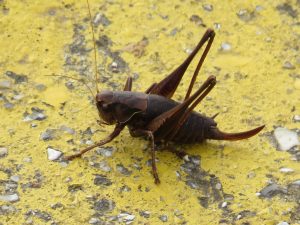
Dark Bush-cricket – Geoff Burton
21st
A late afternoon visit by Andy. There were fresh northerly winds but the rain had eased. Good numbers of Gannets and Brent Geese, 60 Wigeons and a Pintail, eight Golden Plovers, 2 Grey Plovers, 12 Knot and a Bar-tailed Godwits. One juvenile Pomarine Skua was the first of the year and there were two Arctic Skuas and two Great Skuas. There were four Mediterranean Gulls, 22 Little Gulls and eight Kittiwakes. Razorbills and Guillemots were also noted.
20th
Cloudy with a light northerly wind. Northerly winds being as rare as hen’s teeth, uncharacteristically, I made a visit on the Sabbath. There were 20 or more Gannets lingering offshore. A very high skein of 200 Brent Geese which flew east was unusual and there were smaller numbers around particularly in Hampton Bay. Waders included 50 Ringed Plovers, a Sanderling and a Bar-tailed Godwit on Hampton Flats and a Lapwing and a Snipe on the Marsh Pool. Flocks of six and 19 Little Gulls flew west and two Mediterranean Gulls flew east. There were seven adult Great Black-backed Gulls on the tidal ponds and three Sandwich Terns offshore. There was a steady trickle of Chaffinches (132) most heading NW and a tight flock of 40 Siskins zipped west by the Obs. Other birds included a pair of Stonechats, the lingering Wheatear, two Grey Wagtails and two Reed Buntings.
Andy was down in the afternoon and clearly the movement was enhanced. There were more than 100 Gannets offshore, one Velvet Scoter, six Common Scoters, a Great Skua, 67 Little Gulls, 106 Kittiwakes, and an unusual 61 large auks, which included nine Guillemots and four Razorbills. A NW movement of Chaffinches was also noted.
19th
Cloudy with a light southerly wind. Single Red-throated Divers flew east and west, there were six Great Crested Grebes on the sea and two Little Egrets and a Grey Heron on the beach. Waders included four Dunlin, two Bar-tailed Godwits and nine Redshanks on the beach and a Lapwing and a Snipe on the Marsh Pool. There were two Sandwich Terns offshore. A mixed flock of Swallows and House Martins (about 40) were feeding over the area for much of the morning. Five Skylarks flew west, there were four Stonechats in the scrub, a female Blackcap in the scrub and four Chiffchaffs around the area. There were also two Grey Wagtails and a male Kingfisher noted.
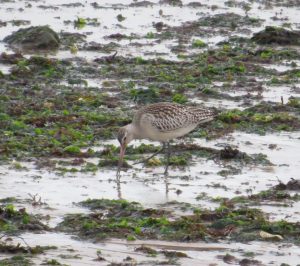
Bar-tailed Godwit – Geoff Burton
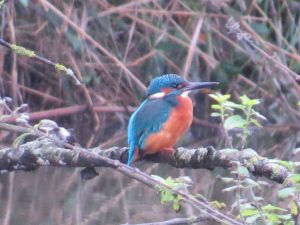
Kingfisher – Geoff Burton
18th
Andy glimpsed a “probable” Dartford Warbler near the bluethroat bush; frustrating as this would have been only the third record for the site (the previous records were in 2001 and 2003). Otherwise, there was a steady movement of Swallows and House Martins and a few Skylarks, Chaffinches and Goldfinches heading west. Two Sanderlings on the beach were the first this month.
Painted Lady and Red Admiral butterflies were also seen.
17th
Cloudy, light southerly wind. There were four Great Crested Grebes offshore, a Red-throated Diver flew west and three Gannets flew east. There were 14 Brent Geese on the shoreline which included six juveniles. A Marsh Harrier, which flew SE over the tidal ponds, was our first since August and a Common Buzzard was the first seen this month. Waders included a Lapwing on the beach and then the Marsh Pool, there were also two Snipe and 15 Redshanks on the pool. One Bar-tailed Godwit was on the beach. There were three Mediterranean Gulls which flew east and four Little Gulls circled over the tidal ponds and then headed south. There were six Sandwich Terns and a Common Tern offshore. Other birds included two Kingfishers, a pair of Stonechats, a Blackcap, four Chiffchaffs and a Goldcrest. There were 30 Swallows and a House Martin and a party of 16 Goldfinches were in the grassland.
16th
There were 15 Gannets, two Mediterranean Gulls and a Razorbill offshore. The Lapwing and 23 Redshanks were on the Marsh Pool. A Wheatear was at the eastern end of the beach, a trickle of Chaffinches, a Swallow and a few House Martins flew through.
15th
Cloudy light SW wind, a shower. There were two Great Crested Grebes on the sea, one Gannet flew east and 55 Brent Geese (36 flew west whilst a party of 19 on the shoreline included six juveniles). One Shelduck flew west and c150 Common Scoters were flying around offshore sometimes landing on the sea and a Teal was sen flying with a party of scoters. . Waders included four Dunlin and a Bar-tailed Godwit On Hampton Flats and a Lapwing and 23 Redshanks on the Marsh Pool at high tide. One Mediterranean Gull flew east, there were four Sandwich Terns and a Common Tern offshore and a Guillemot was seen on the sea. Vis mig was mostly of Chaffinches )100+) with six Skylarks, a Swallow and eight House Martins. Other birds included one Grey Wagtail, two male Stonechats, a Blackcap and five Chiffchaffs, a Goldcrest along the east bank, a Jay flying west, seven Jackdaws over the beach and three Reed Buntings.
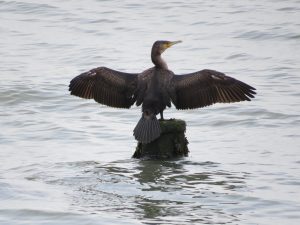
Cormorant – Geoff Burton
14th
Cloudy and calm with steady rain until 10.30 am then dry with a light easterly wind. There were four Gannets offshore, three Little Egrets on the Hampton Flats and a Grey Heron flying towards the tidal ponds. Seven Brent Geese and two Red-breasted Mergansers flew west and eight Common Scoters flew east. Waders included four Snipe and 13 Redshanks on the Marsh Pool and two Bar-tailed Godwits on the Hampton Flats. Two Little Gulls flew west, a Razorbill was on the sea by the tidal ponds and at least four Sandwich Terns continue to linger offshore. Two Swallows flew east, there were three Grey Wagtails in the area, the male Stonechat and three Chiffchaffs were noted and a party of eight Siskins flew west by the Obs.
13th
A glimpse of what might have been on a day when there were no reports from the site. An hours vis mig (9.30-10.30 am) by Andy on the slopes produced 26Lapwings, a Woodlark, 2 Skylarks, c200 Satrlings, c1900 Chaffinches and six Bramblings.
12th
Cloudy and calm. A very quiet day for October even without favourable winds. Waders included two Golden Plovers, a Dunlin and eight Redshanks on the beach. Two Mediterranean Gulls flew east and there were four Sandwich Terns offshore. Two Great Spotted Woodpeckers calling at Lang Court flew out west, a Grey Wagtail was in Church Way and another flew west, there was a female Blackcap along the upper brook and eight Chiffchaffs in the area. One Reed Bunting was in the bushes opposite the Obs.
11th
Andy had four Bramblings heading west during a passage of Chaffinches.
10th
Cloudy with a moderate SW wind. Waders included a Snipe and 12 Redshanks on the Marsh Pool. Sandwich Terns continue to linger offshore with three noted today. Three Skylarks, a Rock Pipit, a Grey Wagtail, five Siskins and one Reed Bunting flew west, there were three Blackaps along the east bank and c10 Chiffchaffs in the area. Other birds included a Kingfisher, a Great Spotted Woodpecker heard calling from the sewage works, five Long-tailed Tits and a Jay.
As well as Small Whites, a Red Admiral and a Small Copper butterfly were seen and a Weasel did the usual scamper across the path by the Obs.
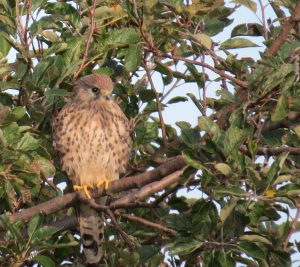
Kestrel – Geoff Burton
9th
Cloudy, cool with a light SW wind. The highlight of the day was all too brief when Andy spotted a Yellow-browed Warbler in a patch of ivy just a few feet away from the three of us (also Geoff and Ted). It flitted out and was then seen only as it moved between bushes before disappearing into the Elm Wood. It wasn’t heard to call. The summer plumage Red-throated Diver was again offshore, there were two Little Egrets on the Marsh Pool and two Grey Herons flew west. A duck Eider close inshore by the Obs drifted east. Waders included 44 Ringed Plovers roosting between the groynes, with one Dunlin, and a Snipe and five Redshanks on the Marsh Pool. A flock of 150 Herring Gulls on the beach included one Pitsea colour-ringed adult (which we had noted on 27th March 2018). One Common Tern flew west. Vis mig consisted mostly of House Martins (350) with 30 Swallows, a Skylark and two Reed Buntings. A Goldcrest and c10 Chiffchaffs wee also seen.
8th
Visible migration of House Martins, Starlings and Chaffinches. Amidst them a “leucistic” Swallow stood out. The pair of Stonechats were also noted.
7th
Cloudy and calm. A movement of wildfowl with 265 Brent Geese, seven Shelducks, 28 Wigeon, six Teal, a Tufted Duck and a Red-breasted Merganser west and four Pintail and six Common Scoters east. One summer plumage Red-throated Diver was on the sea, 59 Little Gulls, a Kittiwake , an Arctic Skua flew west and two Sandwich Terns were offshore. Waders included 20 Dunlin west and seven Redshanks on the Marsh Pool. One Stock Dove, eight Skylarks, a Swallow, a Grey Wagtail and three Reed Buntings flew west. Also noted a male Stonechat, c10 Chiffchaffs, five Long-tailed Tits and two Rooks.
A Painted Lady and a tatty Large White were seen.
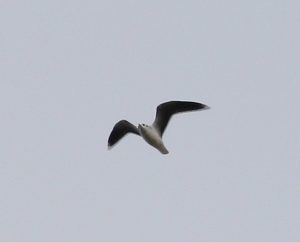
Little Gull – Andy Taylor
5th
Cloudy with a light SW wind. There were two Red-throated Divers offshore, one in full summer plumage, one Gannet flew east, 164 Brent Geese, one Shelduck, 28 Wigeon, three Teal and a Shoveler flew west and six Common Scoters and two Red-breasted Mergansers flew east. Waders included a Lapwing on the beach and six Dunlin. Eight Little Gulls flew west and a Razorbill flew east close inshore. Three Swallows flew west, a Grey Wagtail was in the churchyard, a Wheatear and two Stonechats were in the scrub, there were six Chiffchaffs and a Blackcap, two Jays and two Reed Buntings. Finally, a Goldcrest by the sewage works entrance was new for the year.
4th
Highlight of Andy’s mid-morning visit was a male Ring Ousel in flight over the caravan park whilst two Redwings along the east bank were our first returning birds. Two Red-breasted Mergansers west were also our first of the season and 30 Brent Geese also flew west. There was also a Rock Pipit and two Stonechats and a big movement of hirundines.
Painted Lady and Red Admiral butterflies were also seen.
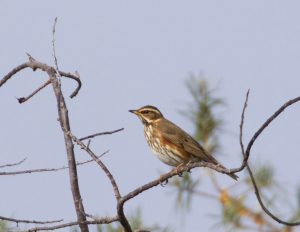
Redwing – Andy Taylor
3rd
Light cloud and calm. A Great Crested Grebe was on the sea, there were four Little Egrets around the tidal ponds and a Grey Heron on the beach. One Brent Goose and one Teal flew west. Waders included a flock of 12 Black-tailed Godwits west, two Grey Plovers, four Dunlin and three Snipe. Other birds included a Great Spotted Woodpecker, four Skylarks west, a Rock Pipit, two Grey Wagtails, a Wheatear, at least ten Chiffchaffs and four Reed Buntings.
2nd
Sunny with a fresh NW wind. Strong onshore (i.e. northerly winds) have been in short supply so far this Autumn. However, this day proved to be a modest haul; Wildfowl included 97 Brent Geese, six Shelducks, seven Wigeon with one Pintail heading west and six Eider and one Common Scoter heading east. Three Arctic Skuas and seven Great Skuas flew west, an Arctic Tern was seen close inshore whilst two Little Gulls circling high above the turbines was an overdue new species for the year (I note that one at Reculver was also a first for the year there). Best was a Manx Shearwater that flew east at 12.15 pm. Waders included 113 Ringed Plovers, with three Dunlin, roosting between the groynes, a Grey Plover on the beach and a Knot flying west. A single Skylark and Rock Pipit flew west and a Stock Dove, a Kingfisher, two Stonechats and a Blackcap were also noted.
1st
Patchy cloud with a light southerly wind. There was one Great Crested Grebe on the sea, a Gannet flew east and a Little Egret and three Grey Herons were on the beach. Waders included a Grey Plover, our first since July, a Curlew flying west and 13 Redshanks on the beach and then the Marsh Pool. There were ten Sandwich Terns offshore. Other birds noted included a Stock Dove, which dropped into the marsh, a Great Spotted Woodpecker, two Grey Wagtails, four Stonechats, a Wheatear on the beach, ten Chiffchaffs, a Jay, 30 Linnets and five Reed Buntings, including four flying west together. A steady if not inspirational start to what is usually the best month of the year!
Butterflies noted were Red Admiral and Small White.
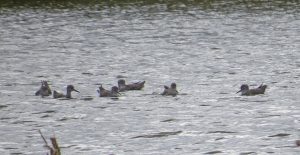
Redshanks on the Marsh Pool – Geoff Burton
